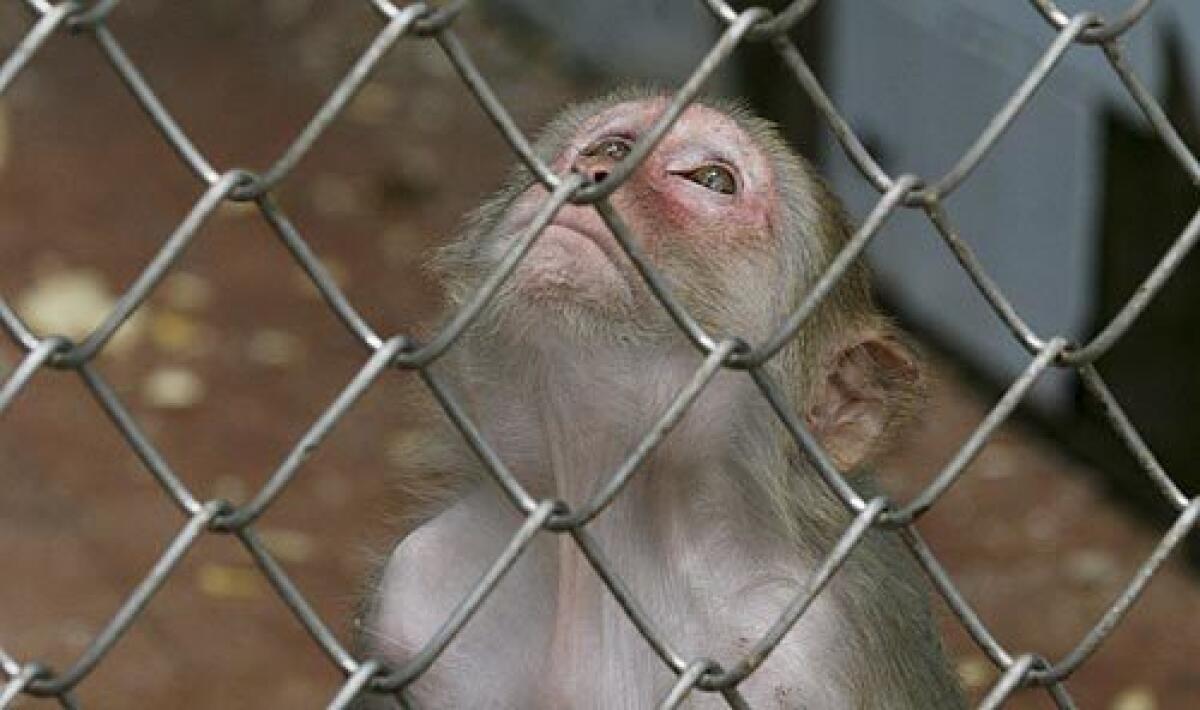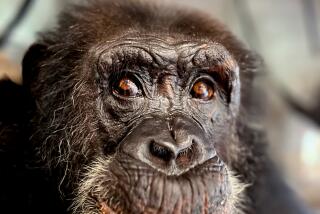Research monkeys languish in a state of limbo

- Share via
SUKHUMI, GEORGIA — They languish in the yard of a war-crushed research center, rattling against the rusting metal of their cages and staring down at the distant blue smudge of the Black Sea.
The inbred clans of traumatized monkeys have managed to survive long years of war, hunger and science, tucked away in the oblivion and isolation of a breakaway republic most people couldn’t find on a map.
History has rolled right past Abkhazia. This strip of lush coast has lingered in a sort of non-time for 15 years, ever since a war for independence from Georgia ended in international stalemate. Since then, Abkhazia has been ruled by a government deemed illegitimate by the rest of the world, stultified by sanctions, jobless and sleepy.
The monkeys of the 91-year-old Research Institute of Experimental Pathology and Therapy have been here all the while.
Few townspeople use the fancy name anymore; they just point toward the building on the hill and speak of the “monkey sanctuary.” The 286 surviving animals are descended from the thousands that populated the laboratories of the Soviet Union’s preeminent primate research institute. Today, people without a country cling to the monkeys because of what they represent: the dimming memory of prestige, and the hope that better days will come.
The cash-strapped government of Abkhazia can’t afford to fill bomb-cratered roads but has managed to keep the institute running. Like the meaningless license plates, flags and passports churned out by the government, the monkeys stand as thin evidence that Abkhazia is a real country.
“We are creating a state. A state cannot exist without science and without institutes,” says institute director Tamaz Kubrava. “The government gives us a miserable sum of money, and our main task is simply to preserve our flock.”
Today, like Abkhazia itself, the monkeys are trapped in an eerie limbo. There’s barely enough money to feed and shelter the primates, let alone cash to run experiments.
Desperate to generate money, the facility has opened to the public as a de facto zoo. People pay $2 a head -- $1 for children -- to wander among monkey cages spaced haphazardly under the fir trees.
“It’s not a zoo,” Kubrava bristles, “it’s a research institute.”
But in the same breath, he muses about restoring a wider swath of the sprawling, bomb-wrecked property, dreaming up more ambitious sightseeing ventures and increasing the price of admission.
“If we restore tourist excursions down the mountain,” he says, “we could increase our profits.”
The animals are leftovers from a more peaceful and prosperous time, when Josef Stalin summered here and tourists from all over the Soviet Union flocked to Abkhazia’s palm-shaded beach resorts. In its heyday, the monkeys provided insight to disease and ventured into space aboard Soviet craft.
Locals are proud of the monkey institute, which they list among such sights as the Russian theater and famed botanical garden. They are also irrepressibly fond of repeating the wild tales of the institute’s storied mad scientist, Ilya Ivanov.
The driving force in a top-secret Stalinist scheme to invent a new breed of low-maintenance Soviet soldier-worker, Ivanov worked feverishly in the 1920s to mate humans and apes. Much of his research was carried out here in Sukhumi, according to institute officials and recently declassified documents published in the Russian press. According to colorful local lore, Soviet prisoners were drafted for the tests.
Scientists at the institute today acknowledge Ivanov’s experiments but say the details were classified and lost to history.
Ivanov later fell out of favor, and died in one of Stalin’s prison camps.
More mundane biological research ground along for the rest of Soviet times, until the war erupted in the early 1990s -- and raged through the laboratories. The buildings are still chewed by shrapnel, the windows busted, some of the structures left to rot.
Many of the monkeys escaped into snowy winters and harsh wilderness, or were freed by sympathetic bystanders who realized they were starving, unwittingly dooming many to death from exposure. In the wildest days of bloodletting, with primates running loose, some of the soldiers took to keeping baby monkeys perched on their shoulders as surreal mascots. Only a few of the animals survived in their cages, kept alive by a few stalwart staff members and tenderhearted locals.
“We are still very grateful to all those people who walked up here every day on foot, under shelling, to feed the monkeys,” says Zinaida Shevtsova, the 78-year-old chief of the immunology and virology laboratory.
War was replaced by sanctions, as the rest of the former Soviet Union cut off all ties with Abkhazia. Slowly, the monkey institute sank into poverty and oblivion.
“When we were under blockade, scientific ties with other countries were lost,” Kubrava says. “People and scientists outside Abkhazia thought we didn’t exist anymore. We only recently started being able to send e-mails to people saying that we exist.”
But the quest to get the escaped monkeys back never quite died out. On a recent morning, Kubrava’s cellphone rings. It’s the only phone he has, he mutters. The land lines don’t work.
“Where did you see it?” he asks excitedly, rising from his chair and pacing behind his desk. “Right on the side of the road? How far from the place? When was it? OK, we’ll see what we can do.”
Someone has spotted a stray monkey, he explains as he hangs up. It happens frequently, part of the painstaking process of tracking down the scattered animals and bringing them back into the fold. All these years later, strays still roam the Abkhazian forests.
“After the war, we had reports of monkey sightings every day,” he said ruefully. “It was both funny and sad.”
Winters in the wild may be harsh and the food scarce, but it’s debatable whether “rescue” qualifies as a happy ending for the animals.
Outside, a damp afternoon molders away in the dense forests. In their ramshackle cages, the monkeys chatter and croon to themselves, cower against the stained concrete walls or chew their fingers and stare woefully down toward the sea. Little trace of their breakfast of oranges and grain remains.
When they spot a passerby with a banana in hand, they crowd to the front of the cages and poke their paws beseechingly through the bars.
The air is thick with the stench of monkey feces. Cold rain drips slowly down through the trees. A stiff sea wind stirs the monkeys’ fur.
Sprawling enclosures where the animals once roamed are now makeshift dumps clotted with rusted cars and mounds of garbage. There is no money to buy new monkeys, and so the remaining animals have developed diseases from inbreeding.
Shevtsova is still talking about the glory days of her career, four decades ago, when she received monkeys with mysterious maladies from all over the world, when she jetted all the way to San Antonio to present her research. Now her experiments have dried up.
“They keep promising to bring us new monkeys,” she says with a sigh. “Maybe when it gets warmer . . . “
For now she rattles around a deserted laboratory, the air filters dangling from the ceiling, the clock on the wall stopped. She pauses between an ancient centrifuge and the boxes where she keeps aging samples of viruses.
“This is a biohazard,” she says cheerfully. And then, without irony, “Can I offer you some coffee?”
These days, the researchers are reduced to studying the effects of post-traumatic stress on the war-haunted monkeys.
The animals give them plenty of material.
“They are depressed,” Kubrava says. “Now they are calming down, little by little. Right after the war they were scared of people, they were inactive and the birthrate was very low.”
The institute recently managed to repair some cages, buy medicine and improve the feed after collecting $40,000 through tourism. Two years ago, it added heated compartments in the back of the cages.
In another sign of what the staff insists is slowly improving health, a 29-year-old monkey recently stunned everybody by giving birth years beyond the usual fertility range.
“You know,” Kubrava muses, “you can’t stop science.”
More to Read
Sign up for Essential California
The most important California stories and recommendations in your inbox every morning.
You may occasionally receive promotional content from the Los Angeles Times.










